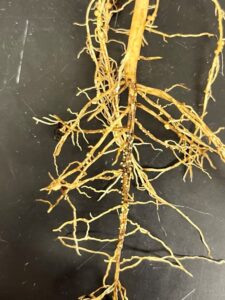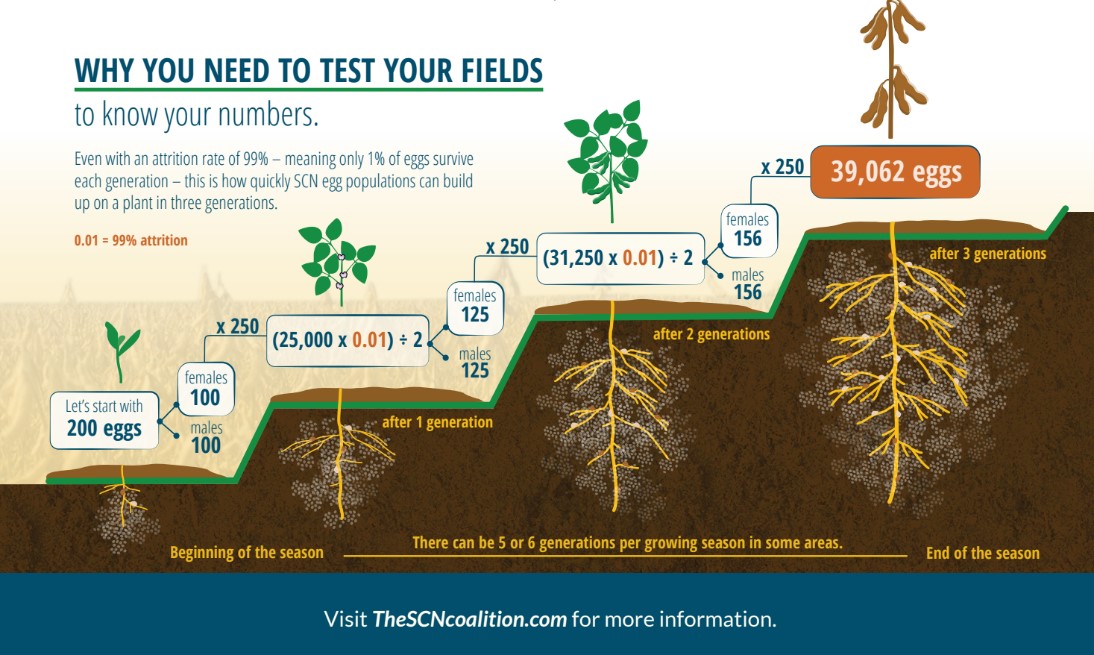Taking soil samples this fall? Why not send them for nematode screening? Take the test and beat the pest! Read on to learn how to take and submit soil samples and the importance of soybean cyst nematode (SCN).
What is SCN?
Soybean cyst nematode (SCN) is a microscopic roundworm that uses its mouthpart, a stylet, to pierce the soybean root. The nematode forms a permanent feeding site inside the host plant. These permanent feedings sites allow the nematode to constantly drive nutrients to itself instead of the plant, but can also lead to further susceptibility to diseases. Soybean cyst nematodes can survive without a host for multiple years, making it very difficult to manage once the population is established.
Why does it matter?
In the south, SCN is estimated to cause the greatest loss with 14.3M bushels lost in 2023 (data from crop protection network). SCN can show symptoms that may be mistaken for nutrient deficiencies: chlorotic leaves, stunted growth, etc. In high populations, the cysts can be seen attached to the roots of soybeans (see Figure 1). Juvenile nematodes enter the root and establish a feeding site (syncytium). The adult female produces between 150-500 eggs, inside and outside of her body. Shortly after mating, the female dies and the body hardens into a cyst, protecting the eggs within. The SCN lifecycle is completed in 20-60 days, demonstrating that SCN populations can rapidly reproduce without control (Figure 2). Fields that are consistently planted with soybean are at a higher risk of soybean cyst nematode infection and yield loss.


Soil sampling fields can be used for detection and monitoring of nematode populations. It’s important to sample so that the best management practices can be implemented (rotation, seed treatment, variety, etc.). If crop rotations have been implemented, it’s important to also test for other plant parasitic nematodes (for example, cotton is a host for reniform nematode which can also cause damage to soybean).
Screening process?
Producers can submit soil samples to be tested for soybean cyst nematode or a full plant parasitic nematode (14 species) screening to the Field Crops Pathology Program in Jackson, TN. Soybean cyst nematode screening is free (due to TN Soybean Promotion Board support) and the cost for a full screening is $15 per sample. Sampling instructions and submission form can be found here: Nematode Sampling Guide and Submission Form 739 (or can navigate to the form through UTcrops.com -> Soybean -> Diseases & Nematodes -> Under publications).
To sample a field:
- The best time to sample is in the fall, after harvest but before the first freeze.
- Collect 15 to 20 1-inch diameter core samples, 6-8” deep, for every 20 acres. Target the root zone of the fields by angling the probe at a 45º
- There are a few approaches to consider when sampling: a zigzag pattern, management zones, or high-risk areas.
- Mix the soil sample cores into one plastic sealable bag and keep cool. Please send the form in with the soil samples.
Ship the samples to the WTREC – Nematode Lab (605 Airways Blvd. Jackson, TN 38301), check made payable to University of Tennessee or can pay online here, just update the quantity as needed.

